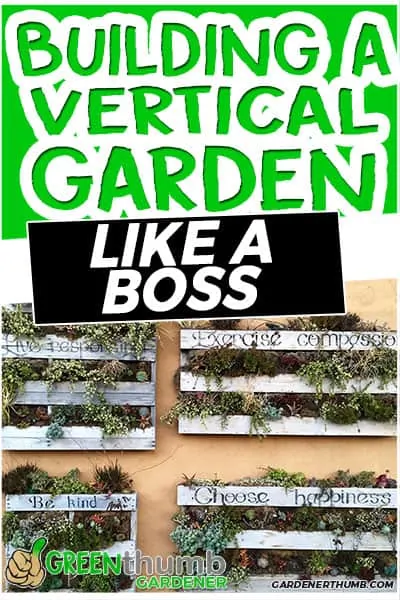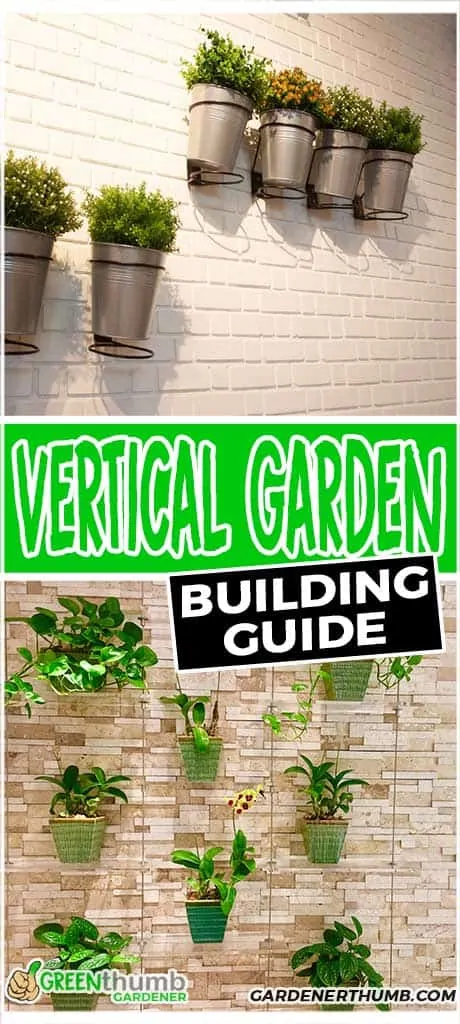How To Build A Vertical Garden
Last updated: 11/17/20
Often, what you need is a small backyard to start your home gardening. However, this can turn out to be tricky without the right information. More so, you probably don’t have enough space as you would have loved.
Well, one thing that can help is a vertical vegetable garden. So, are you wondering how that works? I’ve got you covered.
Here’s how to build a vertical vegetable garden frame.
Green thumb Gardener occasionally links to product and/or services offered by vendors to assist you with all your gardening needs. Some of these may be affiliate links, meaning we earn a small commission if items are purchased.
Want to Download a Garden Hack Guide for FREE

Enter your email below and we will send you a guide to help you SAVE money in your garden.
Choosing the Right Method
Going for a vertical garden is a great choice to turn your small space into your garden. Not only does it bring to reality your dream of having a garden, but it also ensures you can count on a great harvest.
Well, thanks to the popularity of vertical gardens frames, various methods have emerged to achieve this. And they can be quite confusing.
However, don’t let it be. Here are five top methods that you can use to build your vertical vegetable garden frame.
1. Leaning Ladder
My first pick is the use of a leaning ladder to house your plants. What you need to do is simple. You get a leaning ladder that you place against the wall.
Typically, this ladder will have steps that can house plants. Even more, you can customize their number based on your needs. Then, you can begin to plant in them.
However, you’ll need to ensure you place them in an area where they can receive sunlight. And of course, get easy access to water.
The great thing about this option is that it can accommodate quite some vegetables.

You can even plant complementary options together—for instance, you planting marigold with tomatoes to prevent pests. However, movement can be quite difficult with this option, especially where there are loads of steps.
2. Hanging Garden
Another great method for your vertical garden is the hanging garden method that uses no ground area. You can easily hang it on the wall or other areas to get easy access to sunlight. Then, voila, you’re good to go.
You can even take it a step further with a tiered hanging basket. With this option, you have a hanging basket with various tiered compartments. This can reach as many compartments as you need.
Typically, the container comes from plastic, although some varieties come from polyester. You’ll add as much soil as you need and get to planting.
The great thing about this option is that it doesn’t eat up your ground space. However, as a drawback, there’s a restriction on the number of vegetables you can plant.
3. Pallets Garden
One great option is a pallet garden. And this method that started with Fern Richardson is a popular option that allows you to maximize space for planting.
What you’ll need to do is buy pallets or paint cans. Then, you can attach it to your walls or fences using hooks. As always, you can add the soil and ensure proper drainage of your soil.
The great thing about this option is that you can move it easily. This way, you can get access to sunlight when necessary. Even more, the pallets and paint cans are affordable.
4. Succulent Frame Garden
Just before I get to the final option, I’ve got to mention the succulent tray as a great method for your vertical garden. It’s like a nursery flat. As such, this rectangular contraption comes fixed with cells that you can plant in.
Even more, it comes slanted such that your vegetables can enjoy effective aeration when you go with it. Even more, it comes with holes that ensure that drainage is optimal. You can also easily mount it thanks to its built-in bracket. However, you might need to install a wooden frame for a better look.
You can then get to the planting of your favorite veggies.
The great thing about this option is that you’ll do less when it comes to maintenance. Even more, it’s a beautiful sight that you can place outdoors to give your home a splendid look. They even come in varieties, such as the 2-by-2 and 4-by-4. Unfortunately, they are somewhat suited for only shallow-rooted vegetables.
5. Garden Wall
Last on my list is a garden wall. Just like its name, it’s a garden on a wall rather than the ground. Great right?
Typically, this option comes from a combination of terracotta pots, hex wire, and cedar. For this option, you use the cedar as the wall’s frame, while the hex wire represents the wall’s body.
Then, you use the hex wire to hook or tie the terracotta pots to the garden wall. These pots, which are placed vertically, then house the soil for your vegetable plantation.
The great thing about this option is that it allows you to plant loads of vegetables. Even more, thanks to the use of hex wire, there is more air circulation in your vertical garden. However, this construction can require some effort and time from you.
Preparing to Plant
So far, you’ve got great ideas on how to set up your vertical garden. Well, here’s one thing you need to keep in mind. You’ll need to prepare your soil and container for the best result.
So, what can you do? Well, here are things I’ve found useful that will also help you.
Ensure Proper Drainage
I bet you already know that too much water isn’t good for your plants. It’ll only result in waterlogging and rot. Well, this is why there’s a need for proper drainage.
As such, ensure that your pots and containers can properly drain. You’ll need to drill loads of holes in your container. You can also use screen wire. This way, nothing blocks them.
You can even add small stones of about four to six inches.
You can then add your soil. Believe me, with this; you’re one step farther away from rot.

Well-Rotted Compost or Manure
Organic fertilizers are a great choice. They provide your soil with adequate nutrients to ensure that your plants enjoy the best growth.
However, to do this, you need to ensure that the compost or manure is well rotted. Otherwise, you’ll only burn your plants.
As a tip, you can always mix manure with your soil in a ratio of 20 to 80.
Prepare Your Soil
If you truly want an ideal yield, then you need to prepare your soil. And to do this here’s what must happen.
You can add between five to ten pounds of fertilizers to your soil area, reaching 20 feet. Then, in addition to the earlier manure you added, your soil should be rich enough for great growth. You can also reuse the fertilizer trick when your plant begins to grow.
Water Your Plants
You can’t deny the need to water your plants. And this is also important when you opt for a vertical garden. It would be best if you watered your veggies regularly and as at when due.
As such, ensure you don’t water your plants when sunlight is at its peak. The fact is that the soil won’t have the opportunity to soak the water before the sun dries it off.
As such, your best bet would be to do it very early in the morning. Alternatively, you can do it in the evening.
However, ensure that regardless of the time, you focus on the root rather than the leaves. Otherwise, you’ll expose your vegetables to foliage and water-associated diseases.
Plants that will Thrive in a Vertical Garden
Now that you’ve got great options to make your vertical garden. And you’ve also got your soil and container in the best condition; you must be wondering what next.
Well, now you’ll need to plant and transform your garden from mere ideas to reality. And to do this, you’ll need to select a plant. Still, this works perfectly only when you pick plants or vegetables that work best in vertical gardens.
So, are you wondering what your options are? Here you go.
Potatoes
The first plant you can try is potatoes. And it’s a great option because it’s great food. Even more, growing it is without hassle. All you’ll need to do is start growing it early, preferably late fall or early spring.
Also, regardless of the variety, they’ll grow fast. However, you’ll need to ensure that you plant it in loosened soil.
Tomatoes
Our list would be incomplete without tomatoes. And this is because of their great compatibility with vertical gardens. For instance, you can grow most varieties of tomatoes. You can even try various heirloom varieties and be sure to get a great yield.
Also, I would recommend you plant marigolds close to your tomatoes. It helps you repel tomato worms that will ruin your harvest.

Cucumbers
You’ll have a great experience growing cucumbers. They take less space and grow vertically. Even more, as long as you have them picked, they’ll reward you with a bountiful harvest.
The great thing is that you’ll hardly have any trouble growing cucumbers.
Pole Beans
I’m sure that its name already gave it away. But if it didn’t, pole beans are an excellent option if you’re looking to maintain a vertical garden. All you’ll need to do is choose a suitable method that allows its pole to have enough opportunity to grow.
You can even try the purple or yard long pole bean. They have the best taste and hardly stress you during the planting process.
Pumpkins
You can also try out pumpkins. However, you’ll need to be careful that you pick a variety that doesn’t grow too big. You might also need some form of support.
However, regardless of your pick, one thing you can be sure about is a bountiful yield.
Final Thoughts
We all love having a garden. Luckily for us, even in the smallest spaces, there is so much we can do. One thing that’s useful as we try to achieve this is a vertical garden frame.
Not only can you save space, but it also brings beauty, and you can still record a bountiful yield.
So, now that you know, commit to a vertical garden and be sure to have fun.
Related Questions
How do You Build a Vertical Vegetable Garden?
You’ll need a wide range of materials like a wooden pallet, nails, hammer, sandpaper, staple gun, staples, and landscaping paper. Then, you combine the pallet with the nails while removing all rough patches, and you should be ready to go.
Are Vertical Gardens Easy to Maintain?
Yes, you can easily maintain your vertical gardens. In fact, you’ll find it easier to maintain compared to your regular garden as you’ll have fewer reasons to bend and spend less time combating pests.
What Vegetables Grow Well in a Vertical Garden?
You can grow a wide range of vegetables in your vertical gardens such as tomatoes, peas, gourds, pole beans, cucumbers, and squash. You can do this through hanging baskets, pallets, and leaning walls.








